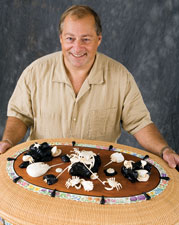Michael Kane’s Magnum Opus
by Elizabeth Stanek
photos by Terry Pommett
|
| The split of the bottom basket’s cover boasts 180 shell carvings. |
“The Last Dance” is something special – the perfect title for a work of art envisioned and anticipated for the past four years. And finally, the masterpiece by lightship basket-maker Michael Kane is ready to be savored.
It’s morning, in early July, and I park on the cobblestone drive outside of Kane’s Sparks Avenue workshop. He meets me at the door in a red polo and khaki shorts, exuding a relaxed, easy air that’s confirmed by his taupe Birkenstocks. I’ve come to see a basket he’s toiled over for so long that it’s practically an island legend.
“It’s a totally functioning sewing basket,” he says, ushering me into a workroom, where rattan hangs from the walls and it appears to have snowed a fine layer of wood dust.
 |
After four years of hard work, Kane displays his labor of love.
|
Face to face with “The Last Dance,” gloriously perched upon the counter, I feel small, like a girl sitting alone at a party when a good song comes on. A two-tiered basket joined by a Honduras mahogany column and a pair of hand-carved dolphins, the piece is about four and a half feet tall, two and two-thirds feet wide and two feet deep.
“I wanted to make a statement. This is what I’m all about,” says Kane.
His creation is a far cry from typical lightship baskets, a traditional Nantucket craft whose roots date back to the native Americans who made wood splint baskets. By 1850, basket-makers had replaced wood splint with cane imported from the South Pacific. The craft took off during the second part of the 19th century, as a way for islanders to whittle away the hours they served aboard lightships, stationed over hazardous offshore shoals.
|










